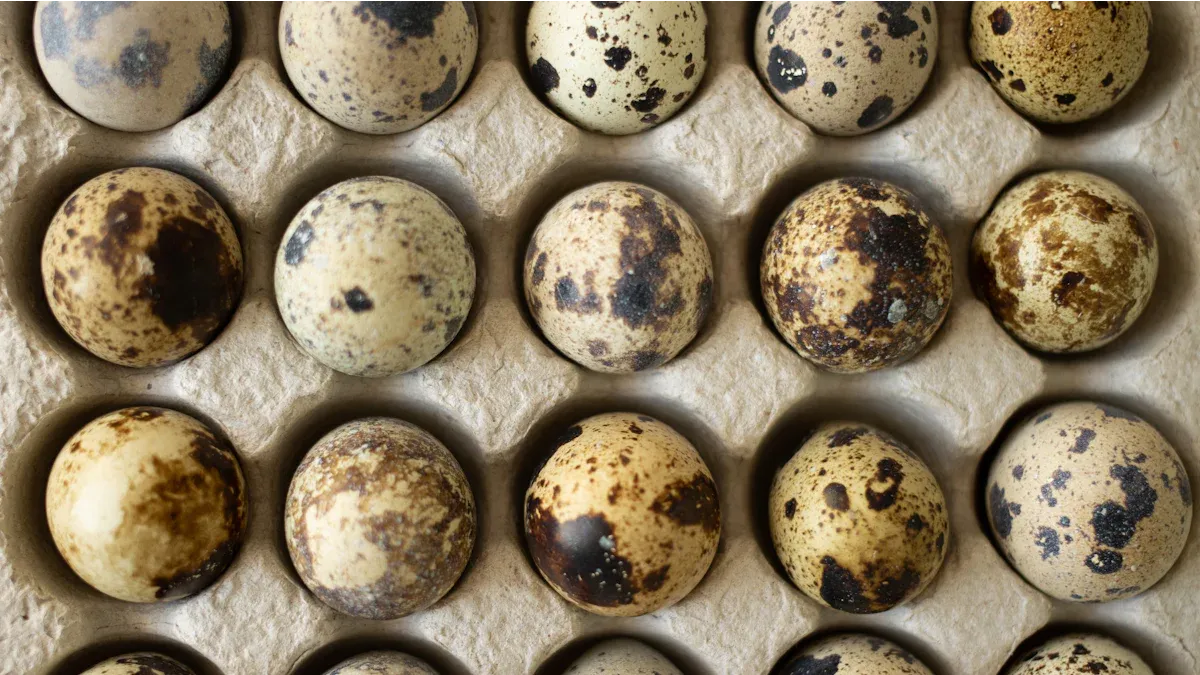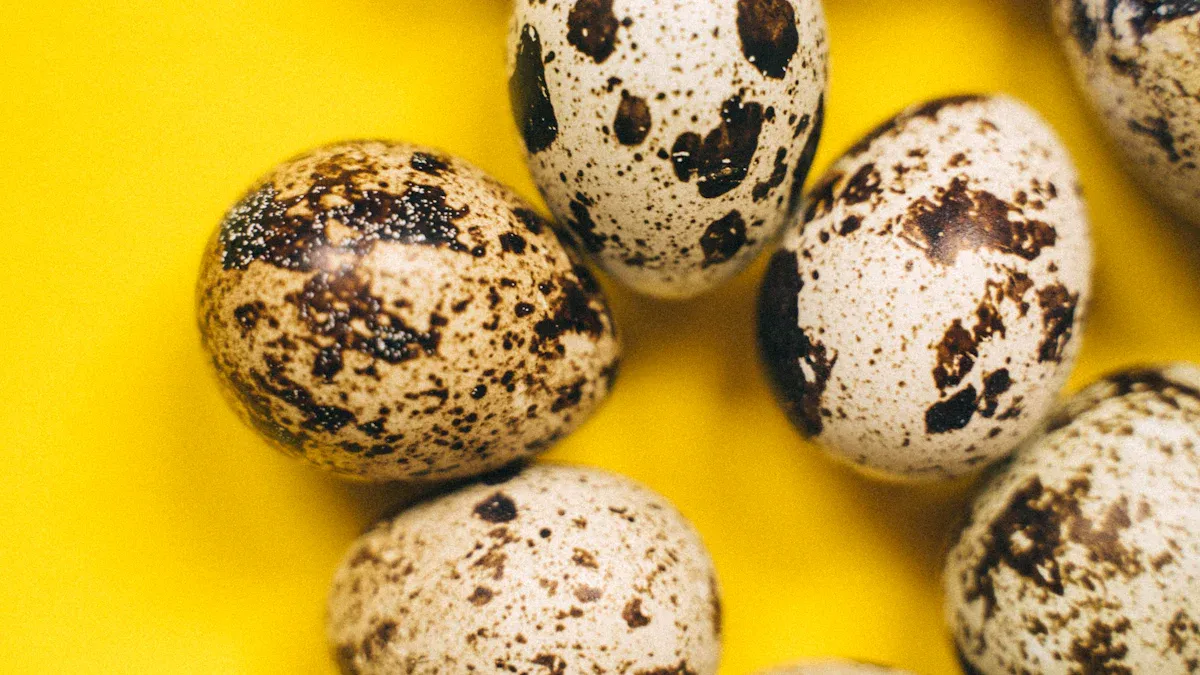Quail egg incubation can seem hard, but you can solve most problems. You notice problems early and make hatch rates better if you act fast.
-
Hatch rates go up when you keep humidity and temperature the same.
-
Good incubators, like the Genesis 1588, help you get better results with quail eggs.
Key Takeaways
-
Keep the temperature steady at 99.5 to 100°F. Make sure humidity stays between 50 and 60% for the first 14 days. This helps more eggs hatch. Turn quail eggs three times each day. This helps the embryo grow right. It also stops it from sticking to the shell. When lockdown starts, raise the humidity to 65 to 75%. Do not open the incubator during this time. This keeps the eggs healthy while they hatch.
Common Quail Egg Incubation Issues

Incubating quail eggs can be tricky. You can learn to spot problems by watching for signs. The table below lists the most common problems you might see:
|
Issue |
Description |
|---|---|
|
Storage Time |
Keeping eggs too long makes embryos weaker and lowers hatch rates. |
|
Critical Development Periods |
Most embryos die early or around day 16 of incubation. |
|
Poor Chick Positioning |
Chicks can die if they are not in the right spot before hatching. |
|
Temperature Effects |
Changes in storage temperature can kill embryos and make hatches worse. |
|
Embryonic Development |
Embryos are easily hurt by changes in the first 5 days and near day 16. |
Temperature Fluctuations
When the temperature changes a lot, you might see these signs:
-
The temperature or humidity is not right.
-
The temperature goes up or down quickly.
-
The temperature keeps changing too much.
These problems can stop eggs from growing. Chicks may die early or not break out of their shells.
Humidity and Temperature Problems
Humidity and temperature are very important for quail eggs. If it is too cold, embryos grow slowly or stop. If it is too hot, chicks can be born with problems or die early. Humidity helps control how much water leaves the egg. Too much humidity can drown chicks. Too little can dry the inside of the egg and make hatching hard.
Improper Egg Turning
Eggs need to be turned during incubation. If you do not turn them right, you might see:
|
Consequence |
Timing |
|---|---|
|
Early Death |
Days 3-6 |
|
Mid-term Death |
Days 7-17 |
|
Failure to Pip |
After development |
|
Dead in Shell |
After Pipping |
Power Outages
Power outages can mess up temperature, humidity, and egg turning. You can wrap the incubator in a blanket to keep it warm for a while. Button quail eggs are very sensitive to temperature changes.
Shipping Trauma
Shipping can shake eggs and move the air cell inside. Check your eggs for this problem when they arrive.
Troubleshooting Quail Egg Incubation
Fixing Temperature Issues
You must keep the temperature steady for quail eggs. If the temperature changes, eggs can have problems. Try these steps to keep the temperature the same:
-
Set your incubator to the right temperature and humidity. Keep the temperature close to 99.5–100°F. Keep humidity at 50–60% for days 1–14. Raise humidity to 65–75% during lockdown.
-
Put the temperature probe at the same level as the eggs. Do not put it near sunlight or vents. This helps you get the right reading.
-
Use two thermometers to check if they are correct. Test one in ice water. It should say 32°F. Test another in boiling distilled water. It should say 212°F.
-
Change the temperature if you see it is different. Open vents if you see water drops inside. This helps keep oxygen in the incubator.
Tip: Check the temperature and humidity every day. Even small changes can hurt hatching quail eggs.
Adjusting Humidity and Temperature
Humidity is just as important as temperature for quail eggs. You need to control both to help eggs hatch. If humidity is too low, eggs dry out. Chicks may not hatch. If humidity is too high, chicks can drown inside the shell.
-
Fill water trays or use wet sponges to make humidity higher.
-
Check humidity at the same height as the eggs.
-
Use a hygrometer to watch humidity levels.
-
Change humidity by moving water trays or opening vents.
-
During lockdown, make humidity higher to help chicks hatch.
Note: The right temperature and humidity help you stop problems and fix them.
Correcting Egg Turning
Turning eggs the right way helps embryos grow well. It stops them from sticking to the shell. You can do these things:
-
Mark one side of each egg with an X. Mark the other side with an O. Use a safe marker.
-
Turn eggs by hand every 8 hours for 14 days. Switch between the X and O sides.
-
Use an automatic egg turner if you want it easier. Make sure it turns eggs three times each day.
-
Stop turning eggs on day 15. Make humidity higher to 65–75%.
Tip: Keep track of which eggs you turn so you do not miss any.
Handling Power Failures
Power outages can mess up incubation. You need to act fast to save your eggs:
-
Keep the incubator closed to keep heat inside. Do not open it. Opening it makes the temperature drop.
-
Cover the incubator with blankets or towels. This keeps it warm.
-
If the power is out for a long time, use a battery heater or generator. This keeps the temperature right.
Emergency steps help you stop problems with chicks not hatching.
Dealing with Failed Hatches
Sometimes chicks do not hatch even if you try hard. Look at your process to make it better next time:
-
Check if eggs were kept too long before incubation. Eggs stored for less time hatch better and make heavier chicks.
-
Write down humidity and temperature for each hatch.
-
Check your egg turning schedule and how you let air in.
-
Learn from each hatch. Write what worked and what did not.
Looking at past hatches helps you make incubation better and keep conditions right.
Remember: During lockdown, keep vents open for air. Quail eggs need fresh air to grow. More airflow helps chicks hatch healthy.
Preventing Incubation Problems
Incubator Setup Tips
You can stop many problems by setting up your incubator right. Put your incubator in a room that stays between 65 and 75°F. Keep it away from windows and sunlight. This helps keep the temperature steady. Run the incubator with no eggs for 24 hours first. Set the temperature to 99.5°F. Make sure humidity is between 45 and 50% for the first 14 days. Put eggs in with the pointed end down. Turn eggs an odd number of times each day. You can use an automatic turner if you want. On days 15 to 18, raise humidity to 65–75%. Do not open the incubator during these days.
Tip: Eggs kept less than 7 days hatch better and chicks hatch together.
Monitoring Humidity and Temperature
Watch humidity and temperature all the time during incubation. Use a thermometer to check the temperature. Use a hygrometer to check humidity. Candle eggs to see the air sac size. This helps you know if humidity is good. Look up the best humidity for your quail eggs. Some incubators let you control humidity and temperature easily. Check often to find problems before they get worse.
Learning from Each Hatch
Write down what happens with every hatch. Record how many eggs you set and how many chicks hatch. Write the age of your quail when they lay their first egg. Track egg size and how many eggs you get each year. These notes help you see what works best. You can pick the best quail to breed and change your process to get better chicks next time.
Hatching Quail Eggs: Best Practices

Lockdown and Humidity
Lockdown is the last part of hatching quail eggs. You should not open the incubator now. If you open it, humidity drops fast. Low humidity dries out the egg’s membrane. This makes it tough for chicks to hatch.
Keep humidity high during lockdown. Most people say to keep it between 65% and 75%. Some use 60% to 65%, but higher is safer. High humidity keeps the shell membrane soft. This stops chicks from drying out before hatching.
-
Do not open the incubator during lockdown.
-
Add water or a wet sponge to make humidity higher.
-
Use a hygrometer at egg level to check humidity.
Here is a simple chart for humidity during incubation and hatching:
|
Stage of Incubation |
Ideal Humidity Range |
|---|---|
|
Incubation |
45–55% |
|
Lockdown |
65-75% |
Tip: More chicks can hatch safely if humidity is high during hatching.
Oxygen and Ventilation
Quail chicks need lots of oxygen when they hatch. Keep the vents open in your incubator. This lets in fresh air and takes out carbon dioxide. Good airflow helps every chick breathe and grow well.
-
Chicks need oxygen and must get rid of carbon dioxide.
-
Embryos need more oxygen as hatching gets close.
-
Forced-air incubators help move air and keep things even.
If vents are closed, chicks may not get enough air. This can make fewer chicks hatch. Always check that vents are open, especially during lockdown.
Note: Good humidity and airflow help your quail hatch healthy.
You can help more quail eggs hatch by doing these things:
|
Key Step |
What You Should Do |
|---|---|
|
Maintain Stable Temperature |
Check with two thermometers to be sure. |
|
Manage Humidity |
Add water or a wet sponge if needed. |
|
Handle Eggs Properly |
Be careful so chicks do not get hurt. |
Studies say that steady humidity and temperature help chicks hatch well. Watch your incubator, make small fixes, and learn after each hatch.
FAQ
Why do my quail eggs not hatch at the same time?
Quail eggs hatch together when you keep temperature and humidity steady. Uneven conditions cause some chicks to hatch early or late.
How often should you turn quail eggs during incubation?
Turn quail eggs three times each day. Use an automatic turner or mark eggs to help you remember. Turning helps embryos grow strong.
What should you do if the incubator loses power?
Keep the incubator closed. Cover it with a blanket to hold heat. Use a battery or generator if you have one. Quick action saves eggs.









0 Comments